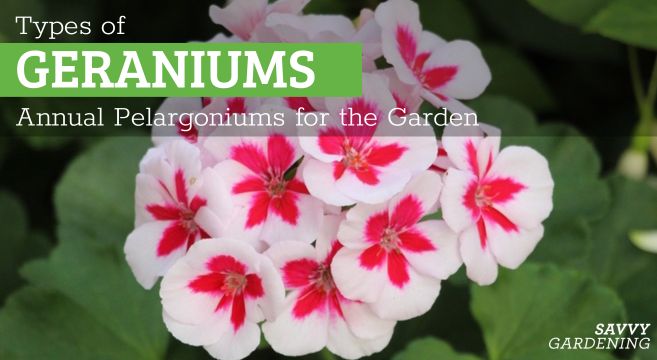This post may contain affiliate links. If you make a purchase through links on our site, we may earn a commission.
When you’re strolling around the garden center, geraniums are among those common, dependable choices in the annuals section that are perfect for both flowerbeds and containers. But have you ever been confused when you wander among the perennials and find geraniums there, too? There are both annual and perennial geraniums. For the purpose of this article, I’m going to focus on annual types of geraniums, which are actually pelargoniums.
Let me explain. Apparently classifying Pelargonium as a geranium stems from a mixup that dates back well over 200 years when pelargoniums were first introduced from southern Africa. Because of the resemblance to the foliage of perennial geraniums, they were mislabelled. This error, while technically corrected, has persisted in the plant vernacular.
Exploring the different types of geraniums
Both annual and perennial geraniums are from the Geraniaceae family. However, the perennial geranium, also called cranesbill, is from the genus Geranium. The annual geraniums that are popular bedding and container plants are from the genus Pelargonium. Why that difference hasn’t made its way to plant tags and signage is confusing. But there are efforts to try and get people referring to pelargoniums as pelargoniums.

Whatever you call them, pelargoniums are attractive annuals that also attract pollinators, like hummingbirds and butterflies, to their vibrant blooms. Petal hues range from red, pink, and orange, to white, fuchsia, and purple.

Zonal geraniums
The flowers of zonal geraniums (Pelargonium x hortorum) are those upright, vibrant balls that you see springing up from the foliage of the plant. The name has nothing to do with growing zones. Rather, it refers to the ring—or zone—of color through each leaf. These bands can be dark green, purple, or various shades of red. Zonal pelargoniums, which are often referred to as common geraniums, can be planted in full sun (at least six hours) to partial shade. Make sure the soil dries out well between watering.
Zonal geraniums perform well in containers. Both the flower and leaf stems stand upright, rather than cascading, which make them great for the garden, too. Position them so those large pompoms full of blooms add height and aren’t shielded by other plants!

If you do plant a zonal geranium in the garden, cut it back and pot it up in the fall to overwinter indoors in a cool, dry part of the house.
Ivy leaf geraniums
Ivy leaf geranium varieties (Pelargonium peltatum) are superstar spillers in pots, hanging baskets, or window boxes. The plants also like to spread outward, so they are natural choices for filling out any container for a lush summer arrangement.
The flowers of ivy geraniums trail over the sides of a container, just like the glossy leaves, which look very similar to English ivy. Plants prefer moist soil and full to partial sunlight. Flowers on ivy pelargoniums are similar to zonal varieties in that the flower clusters form a bit of a pompom. But on these plants, the flowers are a bit further apart.
Be sure to allow the soil to dry out between watering. Though ivy leaf geraniums are self-cleaning, meaning they don’t require deadheading, you still may want to get in there with your garden pruners to keep plants looking fresh.
Regal geraniums
Also referred to as Martha Washington and fancy leaf geranium, Regal geraniums (Pelargonium x domesticum) have really special, ruffled blooms. Generally flowers have two different colors on their petals, similar to a pansy. They don’t mind cooler temperatures and thrive indoors during the winter months as a houseplant. In fact, spring is when you’ll usually find them at the garden center.

Once the warm weather hits and all threat of frost has passed, bring the plant outdoors. Be sure to gradually introduce the plant to the outdoor temperatures, so it isn’t shocked by the sun. And bring it in if there is a sudden frost warning in the late spring. The plant will stop blooming in extremely hot summer weather. Deadhead spent blooms throughout the season to encourage fresh ones.
Scented geraniums
You will find a diverse assortment of aromas among scented pelargonium varieties, from rose and coconut to the popular citronella. With these plants, it’s all about the fragrant foliage—flowers on these varieties tend to be smaller and more delicate. Some types have fuzzy leaves, while others are smooth like their ivy cousins. The fragrance of scented geranium foliage repels certain pests, like bunnies and deer. But the blooms attract a whole host of pollinators. Plants grow well in containers, and in well-draining soil in the garden. Plant them where their scent can be enjoyed by those who pass by.

Scented geraniums are drought tolerant. Plant them in full to partial sun. Be careful not to overwater plants as the stems could rot. Overwinter plants in a bright, sunny window so you can enjoy the scented leaves. Or, allow the plant to go dormant by storing it in a cool basement or garage over the winter. Plants can be brought back outside when you start to plant out other heat lovers, like tomatoes.
Interspecific geraniums
Interspecific pelargoniums are plants that feature the best traits from both ivy and zonal geraniums. It’s possible to cross these plants because they’re from the same genus. The result? Drought- and heat-tolerant plants with stunning double flowers. Plants prefer healthy, well-draining soil. Grow these gorgeous hybrids in full sun to part shade areas of the garden or in container arrangements.





Leave a Reply